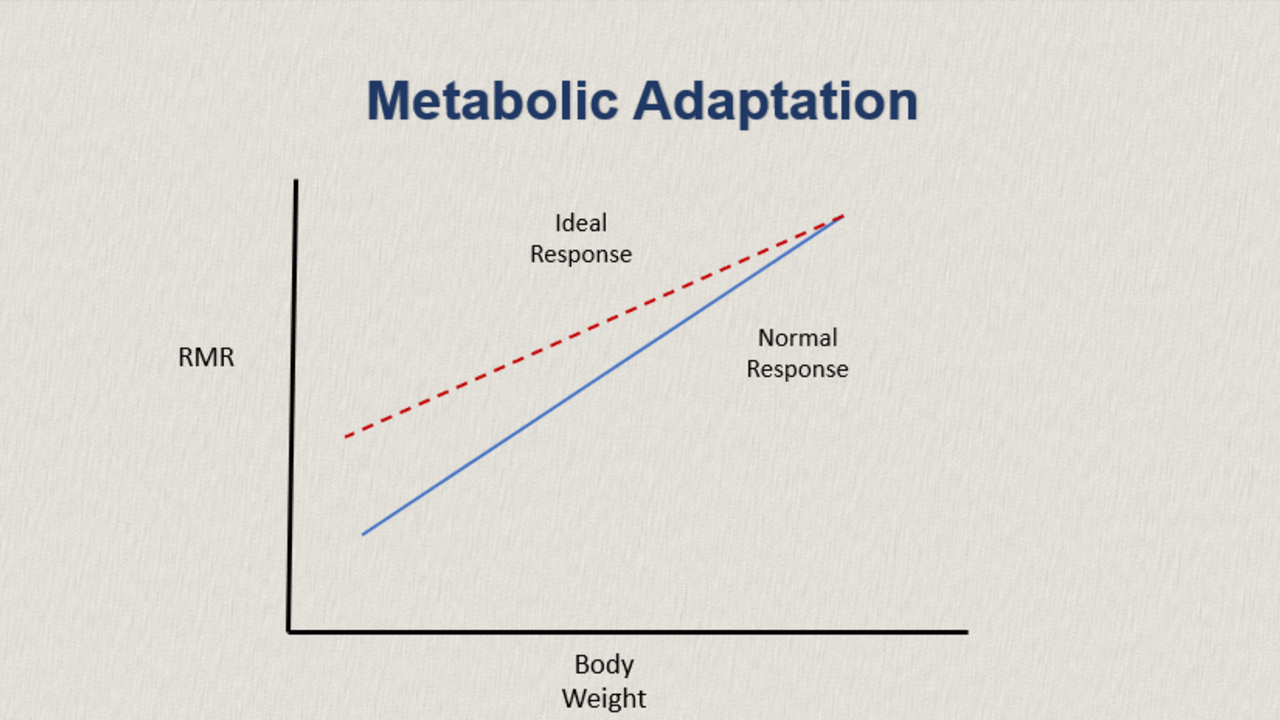Metabolic Adaptation Part I: The Size of the Calorie Deficit

Metabolic adaptation is the abnormal slowing of the metabolism while in a calorie deficit for weight loss. The metabolism is directly influenced by one's body weight. As weight loss occurs, it is expected for the metabolism to slow down. It is widely accepted that metabolic adaptation occurs if the metabolism falls below 15 percent the predicted value when adjusted for body composition (1). Metabolic adaptation occurs if the metabolism falls greater than that during weight loss. A number of factors contribute to metabolic adaptation, but the two that seem to be most influential are the size of the calorie deficit and preservation or loss of lean mass during weight loss.
Weight loss does not always mean fat loss. The faster weight loss occurs, the more likely it is to include lean mass. Unfortunately it is expected that up to 25% of weight loss will come from lean body mass in people who are overweight or obese (2). Lean mass is significantly more metabolically active than adipose tissue (3). It makes the most sense that preserving lean mass during weight loss will help protect the metabolism.
Let's explore the various strategies necessary to protect the lean mass while in a calorie deficit. One of the most significant factors that we have discovered in our years of experience in working with clients is the size of the calorie deficit. The fewer calories ingested, the fewer calories are available to support the energy demand of muscle. So if the calorie deficit is too big, then there is not enough energy, or calories, available to preserve the muscle tissue. The subsequent weight loss will surely include lean mass. However, if the calorie deficit is smaller, then there is a higher likelihood of preserving the muscle mass. The challenge with a smaller deficit is the mindset of the individual.
Many clients are desperate to see a change on the scale. Scale changes mean results - that the diet and exercise plan are working. However the scale doesn't show body composition changes. It only reflects weight shifts, not where that weight is coming from. So this assumption that "things are working" is not based on objective data. The mindset of "I'll do anything to get results" works against people because it makes them be too rigid. The deficit always ends up too big.
The standard of practice and most convenient way to establish a calorie goal is to use a prediction equation for baseline caloric requirements. This is known as an RMR prediction equation. Food tracking apps, fitness trackers and most websites use these equations to figure out how many calories you need. To get the result, you need to enter your height, weight, age and sex into the equation. Some prediction equations use your lean body mass. Many experts believe these equations are more realistic and accurate. However, in our experience no prediction equation is as accurate as a measured resting metabolic rate. (Please see the video on Measured vs. Predicted Metabolism for further explanation.) If you have an actual metabolic rate that is faster than the predicted value, then you will be underestimating your calorie requirements. This will lead to undereating and too big of a calorie deficit, setting you up for the loss of lean body mass.
Coming up: Part II will address how the type of exercise impacts metabolic adaptation.
1.Leibel RL, Rosenbaum M, Hirsch J. Changes in energy expenditure resulting from altered body weight. N Engl J Med. 1995 Mar 9;332(10):621-8. doi: 10.1056/NEJM199503093321001. Erratum in: N Engl J Med 1995 Aug 10;333(6):399. PMID: 7632212.
2. Heymsfield, S. B., Gonzalez, M. C., Shen, W., Redman, L., & Thomas, D. (2014). Weight loss composition is one-fourth fat-free mass: a critical review and critique of this widely cited rule. Obesity reviews : an official journal of the International Association for the Study of Obesity, 15(4), 310–321. https://doi.org/10.1111/obr.12143
3. Müller MJ, Bosy-Westphal A, Kutzner D, Heller M. Metabolically active components of fat-free mass and resting energy expenditure in humans: recent lessons from imaging technologies. Obes Rev. 2002 May;3(2):113-22. doi: 10.1046/j.1467-789x.2002.00057.x. PMID: 12120418.
